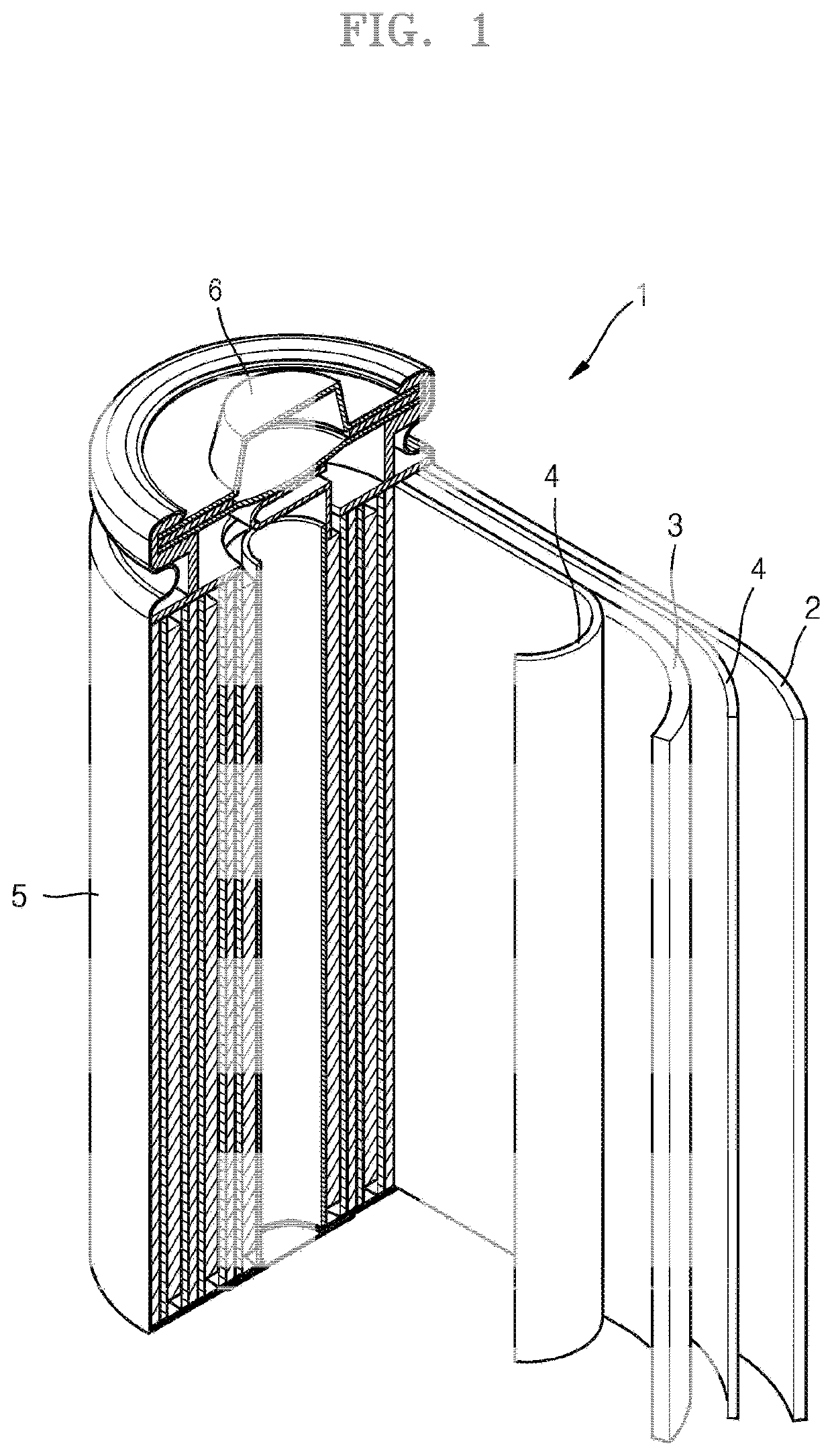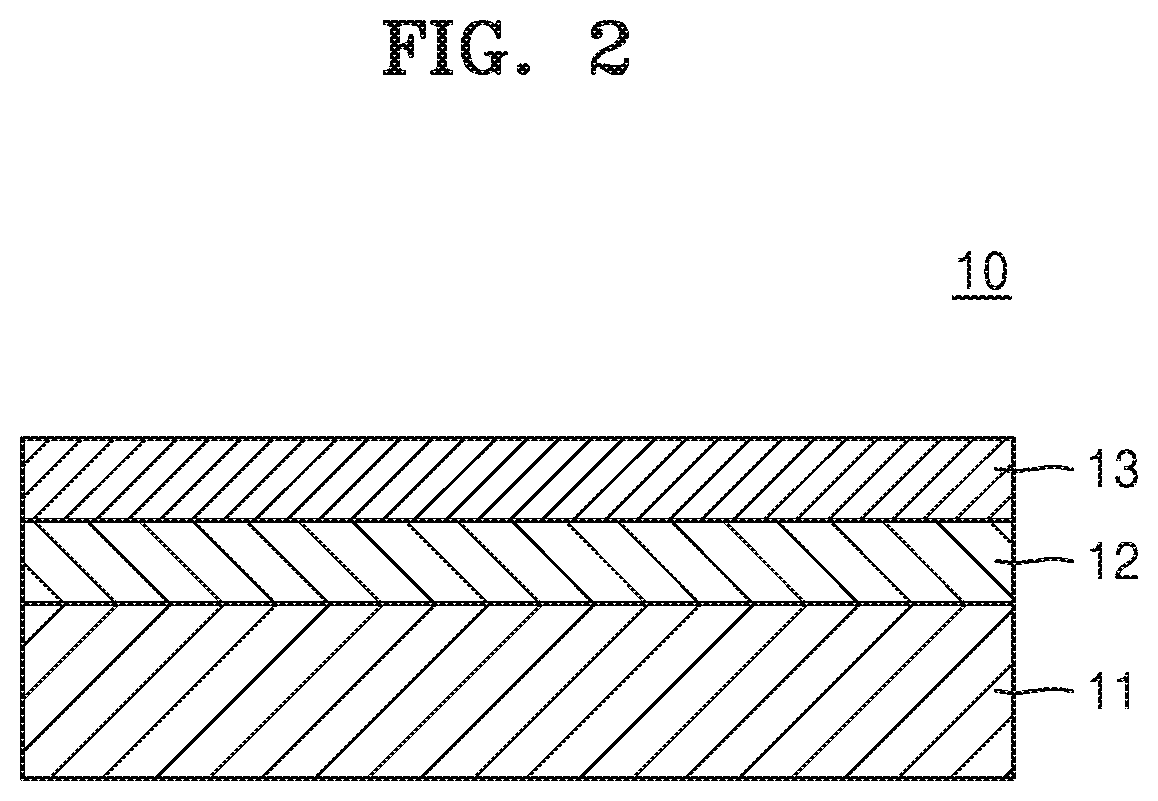Cathode for lithium secondary battery, manufacturing method therefor, and lithium secondary battery comprising same
a lithium secondary battery and cathode technology, applied in the direction of batteries, cell components, electrochemical generators, etc., can solve the problems of remarkable deterioration in performance of such a thick-film electrode plate, difference in charge/discharge depth of active material during the period, etc., to improve lifespan characteristics
- Summary
- Abstract
- Description
- Claims
- Application Information
AI Technical Summary
Benefits of technology
Problems solved by technology
Method used
Image
Examples
example 1
[0164](Manufacture of Cathode)
[0165]96 wt % of LiNi0.8Mn0.1Co0.1O2 as a first cathode active material, 2 wt % of super-p as a conductive material, and 2 wt % of polyvinylidene fluoride as a binder were mixed to prepare a first composition. The first composition was applied onto an aluminum (Al) thin film having a thickness of about 20 μm, which is a cathode current collector, dried at about 80° C. for 20 minutes, and then roll-pressed to obtain a cathode coated with a first layer.
[0166]A second composition, in which 96 wt % of LiNi0.6Mn0.2Co0.2O2 as a second cathode active material, 2 wt % of super-p as a conductive material, and 2 wt % of polyvinylidene fluoride as a binder were mixed, was applied onto the first layer to form a second layer. Then, the second layer was dried at about 80° C. for 20 minutes to prepare a double-coated cathode.
[0167]A third composition, in which 96 wt % of LiNi0.33Mn0.33Co0.33O2 as a third cathode active material, 2 wt % of super-p as a conductive mater...
example 2
[0176]A lithium secondary battery was manufactured in the same manner as in Example 1, except that the current density of the first layer was about 1.2 mAh / cm2, the current density of the second layer was about 0.9 mAh / cm2, the current density of the third layer was about 0.9 mAh / cm2, and the current density ratio of the first layer, the second layer, and the third layer was adjusted to about 4:3:3.
[0177]In this case, the content ratio of the first cathode active material, second cathode active material and third cathode active material in the cathode was 3.6:3.0:3.4.
[0178]Further, the capacity ratio of the first layer, the second layer and the third layer was 4:3:3, the thickness of the cathode active material layer including the first to third layers was about 45 μm, and the total current density thereof was about 3 mAh / cm2.
[0179]In this case, the loading level of the cathode was 15 mg / cm2.
example 3
[0180]A lithium secondary battery was manufactured in the same manner as in Example 1, except that a cathode manufactured by the following method was used.
[0181](Manufacture of Cathode)
[0182]96 wt % of LiNi0.8Mn0.1Co0.1O2 as a first cathode active material, 2 wt % of super-p as a conductive material, and 2 wt % of polyvinylidene fluoride as a binder were mixed to prepare a first composition. The first composition was applied onto an aluminum (Al) thin film having a thickness of about 20 Lm, which is a cathode current collector, dried at about 80° C. for 20 minutes, and then roll-pressed to obtain a cathode coated with a first layer.
[0183]A second composition, in which 96 wt % of LiNi0.33Mn0.33Co0.33O2 as a second cathode active material, 2 wt % of super-p as a conductive material, and 2 wt % of polyvinylidene fluoride as a binder were mixed, was applied onto the first layer to form a second layer. Then, the second layer was dried at about 80° C. for 20 minutes to prepare a double-co...
PUM
| Property | Measurement | Unit |
|---|---|---|
| thickness | aaaaa | aaaaa |
| operation voltage | aaaaa | aaaaa |
| weight ratio | aaaaa | aaaaa |
Abstract
Description
Claims
Application Information
 Login to View More
Login to View More - R&D
- Intellectual Property
- Life Sciences
- Materials
- Tech Scout
- Unparalleled Data Quality
- Higher Quality Content
- 60% Fewer Hallucinations
Browse by: Latest US Patents, China's latest patents, Technical Efficacy Thesaurus, Application Domain, Technology Topic, Popular Technical Reports.
© 2025 PatSnap. All rights reserved.Legal|Privacy policy|Modern Slavery Act Transparency Statement|Sitemap|About US| Contact US: help@patsnap.com



